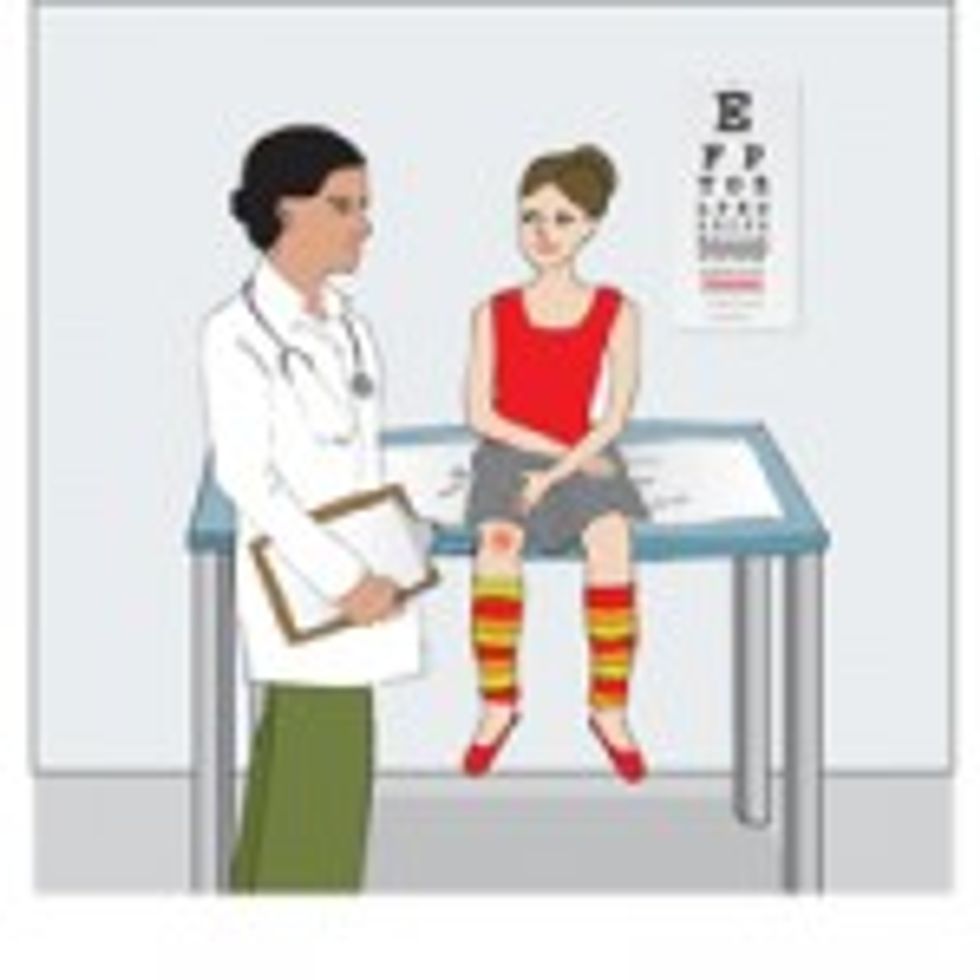Talking To Your Doctor About Injuries

When modern dancer Elizabeth* first saw a neurosurgeon after discovering she had two slipped discs in her back, she was told her condition wasn’t operable. For almost six months, she’d been experiencing nerve pain down her left leg when bending forward or stretching her hamstring, but she still passed the neurological exam with flying colors—she could touch her toes, lift her leg above 90 degrees and all her reflexes were intact. “I thought it must not be that big a deal, since the doctor wouldn’t operate and didn’t tell me to stop dancing,” Elizabeth says.
She continued going to physical therapy, but her condition only got worse and she eventually had to stop dancing entirely. Three years later, she finally did have surgery to fix the slipped discs, after having reached the point where she couldn’t bend forward more than 45 degrees or lift either leg more than a few inches off the ground. “I could have been more aggressive with my first surgeon,” Elizabeth says, “or gone to see a dance specialist sooner. I didn’t communicate to the doctor well enough what my body could do before my injury, and what my job required of me.” After educating herself both on her condition and on how to speak to her physicians about it, she is now on the road to recovery.
Being able to communicate clearly with health care professionals is vital—especially for dancers, whose livelihoods depend upon remaining injury-free. Whether you’re lucky enough to find a dance medicine specialist or only have access to a local orthopedist or family physician, how you explain your pain and your body’s needs will have a direct effect on your treatment. Here are some things to think about.
1. Don’t Minimize Your Pain
Dancers are experts at concealing and dancing through pain. Whether you’ve just landed the role of a lifetime or just can’t bear to take a break, it may seem easier to pretend your injury simply isn’t that bad.
While this is already a risky idea in the studio, it’s an absolute “no-no” in the doctor’s office. “No matter how good the practitioner is, a key element in planning an appropriate treatment program is getting truthful input from the dancer,” says Peter Marshall, company physical therapist at American Ballet Theatre. If you tell a doctor or physical therapist, “My ankle hurts, but I haven’t had to miss a class yet,” he or she might assume that the problem is less serious than it is. Part of getting the best care is being honest about your pain level.
2. Give All the Details
You’ll be asked to give the history of your injury, and you need to go into as much detail as possible. Here’s what your health care practitioner needs to know:
-
The genesis of the injury:
In the case of traumatic or acute injuries, this means how it happened. Let’s say you “landed funny” from a jump. Explain exactly how you landed. Did you roll over the outside of your ankle? Did your knee give way? What type of jump were you doing at the time? (A leap, which has forward momentum, is very different from an up-and-down sauté.) Did you feel pain immediately? Was there a popping or clicking noise? Can the injured body part bear weight?
A long-term, overuse injury requires slightly different information. Be clear about how long you’ve felt pain, if you can recall anything that precipitated the pain (for instance, “I did a tour jeté and whacked my arabesque, and my back hasn’t felt right since”) and whether the pain has remained constant or varied in intensity. You should also share any factors that affect the pain: Does it hurt worse to be sitting or standing, warm and moving, or cold and at rest?
-
Actions that cause pain:
If you’re seeing someone who specializes in treating dancers, this part is easy. Talk about what dance steps you can and can’t do. However, if you don’t have access to someone familiar with dance, you can’t just say, “My hip hurts in rond de jambe en l’air.” Nadia Sefcovic, DPT, a staff physical therapist at Westside Dance Physical Therapy in NYC, explains, “You have to take your dance terminology and put it into layman’s terms.” Make substitutions like “tip-toe” for “relevé” and “split leap” for “saut de chat.” Marshall also recommends demonstrating, either on the non-injured side or with your arms instead of your legs, to help the physician understand.
-
Treatments you’ve tried:
From aspirin to X-rays to acupuncture, your physician or physical therapist needs to know any steps you’ve already taken in the healing process.
-
Other symptoms:
Things that may seem irrelevant to you might be vital in helping your practitioner make a diagnosis. “Certain things trigger something in our minds,” explains Sefcovic. “Being woken up by pain at night, changes in appetite, recent weight loss or gain—you could have a more serious problem that needs to get checked out.”
-
Your usual performance level:
A dancer’s range of motion is greater than the average person’s. If your leg usually goes to 180 degrees in side extension, and now you can only hit 140 without pain, make sure the practitioner understands how your body works. If you can, show your range of motion on the non-injured side, so that the discrepancy is more apparent.
-
Stuff you may not have thought of:
“After you’ve given the history, you may have secondary information that might be helpful,” says Dr. Kenneth Bell, an orthopedic surgeon who works with athletes in East Tennessee and is a team physician at Maryville College. “You could be dancing on a different surface, with a new partner, in a new pair of shoes. You have a show coming up so you’re rehearsing three times a day instead of once. Those types of changes can affect your injury.”
3. Explain Your Dance Life
Your health care practitioner needs to be aware of what being a dancer actually means. “The doctor needs to understand what you do—that this is not just for fun, or occasional, but it’s your avocation and passion,” says Dr. Bell. “If the doctor doesn’t listen to you, then you’ve gone to the wrong doctor.”
Break down how many classes you take a week and in what styles, as well as the format of a typical class. If you’re a ballet dancer, explain the progression from barre to center. For modern or jazz, go over any floorwork or acrobatic skills you might be practicing. Male dancers should talk about the demands of partnering.
Tell the doctor about any commitments you have in the near future, such as competitions, rehearsals and performances. Go over a timeline for treatment with the practitioner early on in the process, both so that you have a goal to reach toward and so that you can notify your teachers if you aren’t able to participate in activities. “Tell the doctor how long you’d like to be out,” Dr. Bell explains. “You might not get an answer you’re happy with, but the doctor should listen to what you say. Having a guide will help the doctor be able to tell you more realistically what to expect as far as the success of your treatment.”
Finally, remind your practitioner of the fitness level you need to reach in order to perform at your best. “An injured dancer generally needs more thorough rehabilitation than an athlete, because we have to strengthen and reeducate muscles to a greater range of motion,” says Marshall. Always communicate your end goal, which may be several steps beyond what a non-dancer would hope to achieve.
4. Think Positive
Although pain is the reason you’re seeking medical attention in the first place, Sefcovic points out that for long-term rehabilitation, it’s better to focus on ability than pain. “It helps with the psychological side of being injured,” she explains. “Focus on the positive and how far you’ve come. Don’t say, ‘I still can’t do big jumps’; instead, look at it as, ‘I can complete barre and all of center except grande allegro.’” Not only will taking note of positive progress improve your morale, but you’re also keeping your practitioner apprised of how you’re really healing, even if it sometimes seems to be incremental. Remember that you and your doctor or physical therapist should be in it together, and the information you give in the exam and rehabilitation settings can help you end up back where you belong: onstage.




